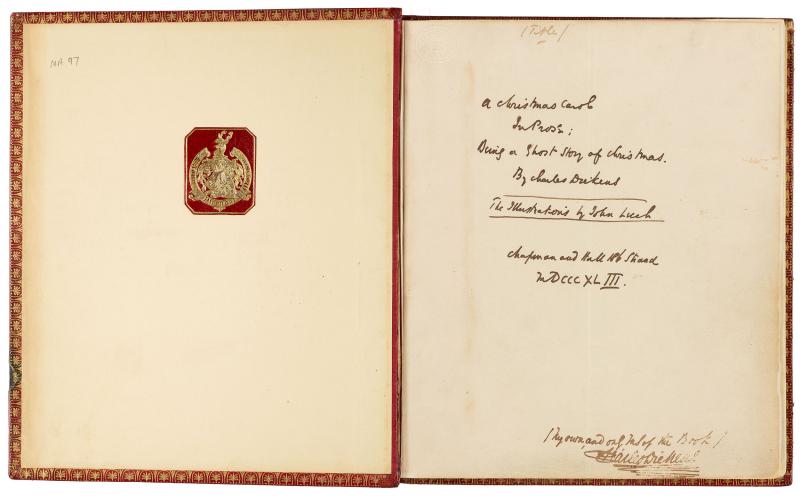A Christmas carol in prose : being a ghost story of Christmas : autograph manuscript signed, 1843 Dec.

Download image:
Record ID:
160509
Accession number:
MA 97
Date:
1843 Dec.
Credit:
Purchased by Pierpont Morgan, before 1900.
Description:
1 item (68 p.), bound ; 23.4 cm
Notes:
High reserve.
Includes extensive revisions.
On the title page: "A Christmas Carol / In Prose; / Being a Ghost Story of Christmas. / By Charles Dickens / The Illustrations by John Leech / Chapman and Hall No. 6 Strand / MDCCCXLIII. / My own, and only, MS of the Book"; signed by Charles Dickens.
Preface dated "December 1843" and signed "CD."
Signed on the back flyleaf by Francis Hopkinson Smith (dated Nov. 20, 1914) with a note from Belle Greene.
Housed in:
Maroon cloth drop-spine box with tan paper cover (28.1 cm)
Binding:
Red leather, gilt-tooled, lettered "Thomas Mitton Esqre." on upper cover and "A Christmas Carol / Dickens / MDCCCXLIII" on spine (23.5 cm).
Provenance:
Presented by the author to Thomas Mitton, his childhood friend and onetime solicitor. In 1875 Thomas Mitton sold the manuscript to Francis Harvey, bookseller, for £50. Purchased by Henry George Churchill (autograph collector who had it photographed; 750 facsimile copies were made from these photographs). In 1882 Churchill consigned it to Bennett, a Birmingham bookseller, who sold it for £200 to Robson and Kerslake of London. Robson and Kerslake sold it to Stuart M. Samuel (of Samuel Montagu & Co.) for £300. Purchased by the London bookseller J. Pearson & Co., presumably from Samuel, for £1000. Purchased by Pierpont Morgan before 1900 from J. Pearson & Co.
Catalog Link:
Department:
Compelled by personal financial difficulties, Dickens wrote A Christmas Carol in only six weeks, during a period of intense creativity in fall 1843. The original manuscript of A Christmas Carol reveals Dickens's method of composition, allowing us to see the author at work. The pace of writing and revision, apparently contiguous, is urgent, rapid, and boldly confident. Deleted text is struck out with a cursive and continuous looping movement of the pen and replaced with more active verbs--to achieve greater vividness or immediacy of effect--and fewer words for concision. This heavily revised sixty-six-page draft--the only manuscript of the story--was sent to the printer in order for the book to be published on 19 December, just in time for the Christmas market.
When the manuscript of A Christmas Carol was returned by the printer, Dickens sent it to a bookbinder (possibly Thomas Robert Eeles of Cursitor Street, London), who bound it in crimson morocco, a handsome, durable goatskin leather. The binding is elegantly decorated in gilt, and the name "Thomas Mitton Esqre" is stamped in gilt on the front cover. Dickens presented the bound manuscript to Mitton, his close friend and creditor, possibly as a Christmas gift, and most probably in gratitude for the generous loan of £270 in the preceding six months.